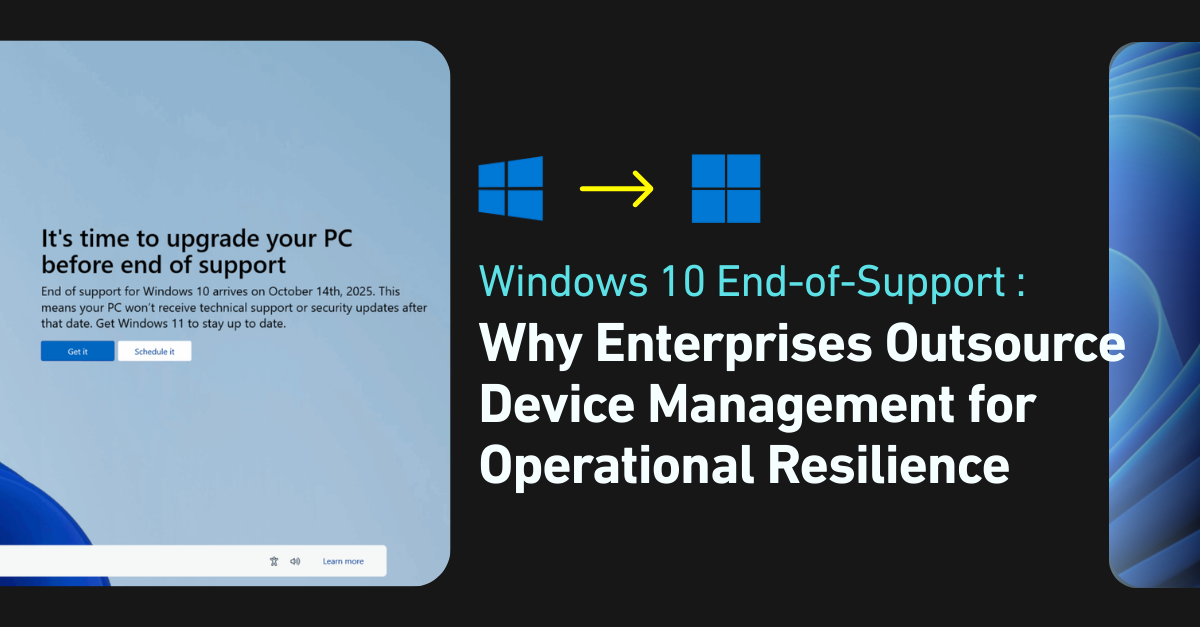Enterprise Managed Services
Windows 10 End-of-Support: Why Enterprises Outsource Device Management for Operational Resilience

Microsoft’s decision to end Windows 10 support in October 2025 poses a critical challenge for enterprises. Without security updates or technical support, Windows 10 devices will become vulnerable to cyber threats, compliance issues, and downtime. The transition to Windows 11 is a laborioustask, but inaction risks data breaches, regulatory penalties, and operational disruptions, particularly in industries where device uptime is critical, such as retail or finance. The Windows 10 deadline is a wake-up call for IT leaders to adopt a proactive device management strategy to streamline device lifecycle management and minimise operational risks.
The Strategic Value of Outsourced Device Management
Outsourcing device management to a specialised managed service provider enables enterprises to address ad-hoc issueslike the Windows 11 upgrade or security patch updates while streamlining day-to-day operations and enhancing employeeexperience with fast end-user support. Below are the key benefits for operational efficiency and business continuity.
1. Seamless Lifecycle Management
Enterprises face significant challenges to manage diverse devices – PCs, mobiles, printers, firewalls, access points, POS systems, and more. Each device type has unique hardware, operating systems and lifecycles. Effective lifecycle management provides visibility into device status, enabling proactive decisions. For example, an enterprise can identify aging routers or access points to facilitate proactive procurement before equipment fails and disrupts network operations. Similarly, lifecycle management ensures IT leaders are always aware of warranty expiration dates for devices like firewalls or laptops, allowing timely renewals or replacements to avoid unexpected downtime. Outsourcing device management support this process by offering:
- Planning and Deployment: Strategic procurement of compatible devices and seamless deployment across all device types.
- Migration and Onboarding: Coordinated upgrades with minimal disruption, supported by user training for rapid adoption.
- Degaussing and Decommissioning: Secure data erasure and responsible recycling, ensuring corporate compliance.
This end-to-end approach ensures smooth transitions across diverse devices, maintaining productivity.
2. Operational Efficiency Through Centralised Management
The diversity of devices in large enterprises often leads to fragmented processes, inconsistent policies, and manual tracking, driving inefficiencies. For example, tracking the location and warranty of thousands of routers and access points, or ensuring tablet systems are updated, can overwhelm in-house IT teams. Tablets and mobiles may run different operating systems (e.g., iOS, Android), requiring distinct management protocols. Outsourced device management delivers:
- Integrated Asset Management: Regular stocktaking and real-time tracking of ownership, location, and warranties of all devices, reducing costs and ensuring audit readiness.
- Proactive Monitoring: AI-driven insights to predict and prevent failures on Access Points and other network equipment.
- Actionable Insights: Reports for lifecycle planning to aidprocurement decision and facilitate better IT budget planning.
Centralised management frees IT teams to focus on strategic priorities, enhancing overall efficiency.
3. Business Continuity Through Enhanced End-userSupport
The growing number of end-user devices increases the chance of interruptions if end-user support is inadequate. Effective device management mitigates this by prioritising seamless user experiences:
- 24/7 Support: Integrated helpdesk provides quick remote diagnostics round the clock, while onsite multiskilled engineers resolve more complicated issues, minimising disruptions across devices like PCs, mobiles and Wi-Ficonnections.
- User Onboarding: Comprehensive training on new devices to ensure smooth adoption and onboarding, regardless of device diversity.
These prioritise end-user productivity, reduce frustration, and enable seamless device adoption, maintaining uninterruptedoperations.
Time to Rethink the Device Strategy
The Windows 11 upgrade is a critical wake-up call for IT leaders to reassess their device management approach. HKT Enterprise Managed Services (EMS) provide an integrated platform, EMSConnect, which seamlessly combines IT Asset Management (ITAM), IT Service Management (ITSM), and IT Operations Management (ITOM) with industry best practices. This solution enables comprehensive device inventory tracking, identifies equipment nearing end-of-lifecycle for timely replacements, and prevents overstock or understock issues to optimise resource allocation. Through its Device Managed Service, EMS works as an extension of your in-house IT to streamline device management processes whiledelivering comprehensive end-user device support. Contact our EMS experts for a technology assessment and unlock your IT’s strategic potential with a future-ready device management strategy.